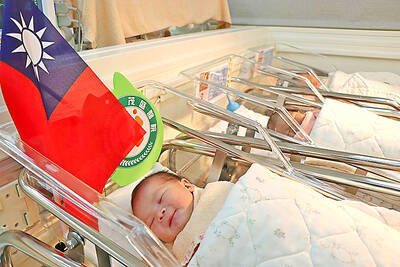Japan yesterday approved a plan to develop with the US a next-generation shipborne missile defense system, amid growing concern about North Korea and rising tension between Japan and China.
The government decided to launch development of the system in the financial year starting in March next year. It is based on the US sea-based Standard Missile 3 (SM-3) after six years of joint research.
"The missile defense system is purely and solely defensive in nature to protect the lives and assets of the people," Chief Cabinet Secretary Shinzo Abe said in a statement after the decision.
"It is appropriate to proceed with the joint development in order to secure the capability to deal with the threat of ballistic missiles," he said, despite lingering doubts about the precision of such a system.
Japan has been in a hurry to build a missile defense system with the US since North Korea stunned the world in 1998 by firing a missile over the Japanese mainland into the Pacific.
Analysts say North Korea is developing long-range missiles capable of reaching Alaska, Hawaii and perhaps the US West Coast.
Japan's Defense Agency said earlier this month that the US and Japanese militaries are looking at a site in Aomori, about 580km northeast of Tokyo, to base a radar system for the missile shield. The high-resolution radar is expected to be able to discriminate targets from decoys.
The Cabinet of Prime Minister Junichiro Koizumi approved a ?3 billion (US$2.5 million) budget for the next financial year for development costs as requested by the Defense Agency.
It also earmarked ?700 million for remaining work on the joint research.
Abe, the top government spokesman, said that the joint missile project would be carried out without infringing on Japan's strict control on exports of arms.
The SM-3 is part of an anti-missile shield which includes the land-based surface-to-air PAC-3.
SM-3s intercept ballistic missiles when they reach their highest point outside of the atmosphere and PAC-3 missiles are used to destroy missiles that evade SM-3 interceptions.
The SM-3 interceptors will be based on destroyers equipped with the state-of-the-art Aegis air-defense system.
Fukushiro Nukaga, the state minister for defense, said last week Japan would shoulder about US$1 billion to US$1.2 billion of the cost of the nine-year project. The US side is expected to chip in US$1.1 billion to US$1.5 billion dollars.
"The system will contribute to stability in the region as it will strengthen our country's defense capability ... amid the proliferation of ballistic missiles," he told reporters yesterday.
"We hope to spare no effort in explaining the purpose of the [missile] policy pursued by Japan and the US," he added.
The missile-defense project has been a major part of the strengthened Japan-US military alliance in recent years and is excluded from Japan's ban on arms exports.
In 1967, Japan banned exports of weapons to the Communist bloc, countries under UN sanctions and those in international conflicts. The government tightened the ban in 1976 preventing all arms exports regardless of destination. But transfer of military technology to the US was made an exception.

Conflict with Taiwan could leave China with “massive economic disruption, catastrophic military losses, significant social unrest, and devastating sanctions,” a US think tank said in a report released on Monday. The German Marshall Fund released a report titled If China Attacks Taiwan: The Consequences for China of “Minor Conflict” and “Major War” Scenarios. The report details the “massive” economic, military, social and international costs to China in the event of a minor conflict or major war with Taiwan, estimating that the Chinese People’s Liberation Army (PLA) could sustain losses of more than half of its active-duty ground forces, including 100,000 troops. Understanding Chinese

The Ministry of Foreign Affairs (MOFA) yesterday said it is closely monitoring developments in Venezuela, and would continue to cooperate with democratic allies and work together for regional and global security, stability, and prosperity. The remarks came after the US on Saturday launched a series of airstrikes in Venezuela and kidnapped Venezuelan President Nicolas Maduro, who was later flown to New York along with his wife. The pair face US charges related to drug trafficking and alleged cooperation with gangs designated as terrorist organizations. Maduro has denied the allegations. The ministry said that it is closely monitoring the political and economic situation

UNRELENTING: China attempted cyberattacks on Taiwan’s critical infrastructure 2.63 million times per day last year, up from 1.23 million in 2023, the NSB said China’s cyberarmy has long engaged in cyberattacks against Taiwan’s critical infrastructure, employing diverse and evolving tactics, the National Security Bureau (NSB) said yesterday, adding that cyberattacks on critical energy infrastructure last year increased 10-fold compared with the previous year. The NSB yesterday released a report titled Analysis on China’s Cyber Threats to Taiwan’s Critical Infrastructure in 2025, outlining the number of cyberattacks, major tactics and hacker groups. Taiwan’s national intelligence community identified a large number of cybersecurity incidents last year, the bureau said in a statement. China’s cyberarmy last year launched an average of 2.63 million intrusion attempts per day targeting Taiwan’s critical

AGING: As of last month, people aged 65 or older accounted for 20.06 percent of the total population and the number of couples who got married fell by 18,685 from 2024 Taiwan has surpassed South Korea as the country least willing to have children, with an annual crude birthrate of 4.62 per 1,000 people, Ministry of the Interior data showed yesterday. The nation was previously ranked the second-lowest country in terms of total fertility rate, or the average number of children a woman has in her lifetime. However, South Korea’s fertility rate began to recover from 2023, with total fertility rate rising from 0.72 and estimated to reach 0.82 to 0.85 by last year, and the crude birthrate projected at 6.7 per 1,000 people. Japan’s crude birthrate was projected to fall below six,